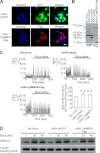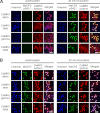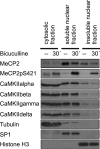Nuclear calcium signaling controls methyl-CpG-binding protein 2 (MeCP2) phosphorylation on serine 421 following synaptic activity
- PMID: 22822052
- PMCID: PMC3438929
- DOI: 10.1074/jbc.M112.382507
Nuclear calcium signaling controls methyl-CpG-binding protein 2 (MeCP2) phosphorylation on serine 421 following synaptic activity
Abstract
The function of MeCP2, a methylated DNA-interacting protein that may act as a global chromatin modifier, is controlled by its phosphorylation on serine 421. Here we show that in hippocampal neurons, nuclear calcium signaling controls synaptic activity-induced phosphorylation of MeCP2 on serine 421. Pharmacological inhibition of calcium/calmodulin-dependent protein (CaM)kinases blocked activity-induced MeCP2 serine 421 phosphorylation. CaM kinase II (CaMKII) but not CaMKIV, the major nuclear CaM kinase in hippocampal neurons, appeared to mediate this phosphorylation event. Biochemical subcellular fractionations and immunolocalization studies revealed that several isoforms of CaMKII (i.e. CaMKIIα, -β, -γ, and -δ) are expressed in the cytosol but are also detectable in the cell nucleus of hippocampal neurons, suggesting that nuclear CaMKII catalyzes MeCP2 serine 421 phosphorylation. Thus, in addition to the classical nuclear calcium-CaMKIV-CREB/CBP (cAMP-response element-binding protein/CREB-binding protein) pathway that regulates transcription of specific target genes, nuclear calcium may also modulate genome-wide the chromatin state in response to synaptic activity via nuclear CaMKII-MeCP2 signaling.
Figures






Similar articles
-
Nuclear calcium signaling induces expression of the synaptic organizers Lrrtm1 and Lrrtm2.J Biol Chem. 2015 Feb 27;290(9):5523-32. doi: 10.1074/jbc.M113.532010. Epub 2014 Dec 19. J Biol Chem. 2015. PMID: 25527504 Free PMC article.
-
CREB/CBP and SRE-interacting transcriptional regulators are fast on-off switches: duration of calcium transients specifies the magnitude of transcriptional responses.J Neurochem. 2001 Nov;79(4):849-58. doi: 10.1046/j.1471-4159.2001.00645.x. J Neurochem. 2001. PMID: 11723177
-
Increasing levels of wild-type CREB up-regulates several activity-regulated inhibitor of death (AID) genes and promotes neuronal survival.BMC Neurosci. 2012 May 18;13:48. doi: 10.1186/1471-2202-13-48. BMC Neurosci. 2012. PMID: 22607375 Free PMC article.
-
Nuclear calcium signaling.Adv Exp Med Biol. 2012;970:377-405. doi: 10.1007/978-3-7091-0932-8_17. Adv Exp Med Biol. 2012. PMID: 22351065 Review.
-
Physiological and Pathological Roles of CaMKII-PP1 Signaling in the Brain.Int J Mol Sci. 2017 Dec 22;19(1):20. doi: 10.3390/ijms19010020. Int J Mol Sci. 2017. PMID: 29271887 Free PMC article. Review.
Cited by
-
The effect of exercise and physical activity on skeletal muscle epigenetics and metabolic adaptations.Eur J Appl Physiol. 2025 Mar;125(3):611-627. doi: 10.1007/s00421-025-05704-6. Epub 2025 Jan 8. Eur J Appl Physiol. 2025. PMID: 39775881 Review.
-
δ-Opioid receptor activation rescues the functional TrkB receptor and protects the brain from ischemia-reperfusion injury in the rat.PLoS One. 2013 Jul 2;8(7):e69252. doi: 10.1371/journal.pone.0069252. Print 2013. PLoS One. 2013. PMID: 23844255 Free PMC article.
-
Nuclear calcium signaling induces expression of the synaptic organizers Lrrtm1 and Lrrtm2.J Biol Chem. 2015 Feb 27;290(9):5523-32. doi: 10.1074/jbc.M113.532010. Epub 2014 Dec 19. J Biol Chem. 2015. PMID: 25527504 Free PMC article.
-
Roles of calcium signaling in cancer metastasis to bone.Explor Target Antitumor Ther. 2022;3(4):445-462. doi: 10.37349/etat.2022.00094. Epub 2022 Aug 31. Explor Target Antitumor Ther. 2022. PMID: 36071984 Free PMC article. Review.
-
Association of CaMK2A and MeCP2 signaling pathways with cognitive ability in adolescents.Mol Brain. 2021 Oct 4;14(1):152. doi: 10.1186/s13041-021-00858-8. Mol Brain. 2021. PMID: 34607601 Free PMC article.
References
-
- Fuks F., Hurd P. J., Wolf D., Nan X., Bird A. P., Kouzarides T. (2003) The methyl-CpG-binding protein MeCP2 links DNA methylation to histone methylation. J. Biol. Chem. 278, 4035–4040 - PubMed
-
- Chen W. G., Chang Q., Lin Y., Meissner A., West A. E., Griffith E. C., Jaenisch R., Greenberg M. E. (2003) Derepression of BDNF transcription involves calcium-dependent phosphorylation of MeCP2. Science 302, 885–889 - PubMed
-
- Shahbazian M. D., Antalffy B., Armstrong D. L., Zoghbi H. Y. (2002) Insight into Rett syndrome: MeCP2 levels display tissue- and cell-specific differences and correlate with neuronal maturation. Hum. Mol. Genet. 11, 115–124 - PubMed
Publication types
MeSH terms
Substances
LinkOut - more resources
Full Text Sources

